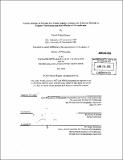Geomicrobiology of nitrogen in a coastal aquifer : isotopic and molecular methods to examine nitrification and denitrification in groundwater
Author(s)
Rogers, Daniel Richard
DownloadFull printable version (10.00Mb)
Alternative title
Isotopic and molecular methods to examine nitrification and denitrification in groundwater
Other Contributors
Woods Hole Oceanographic Institution.
Advisor
Karen Casciotti.
Terms of use
Metadata
Show full item recordAbstract
Excess nitrogen input is deleterious to coastal waters, resulting in deterioration of the water quality, increases in harmful algal blooms and disease in commercial fish stocks. A significant portion of this nitrogen enters coastal waters through groundwater systems. Here we use isotopic and molecular biological methods to identify the populations of nitrifiers and denitrifiers, where they occur, and what levels of activity are present through the upper four meters of a coastal groundwater system. This work shows two different populations of putative ammonia-oxidizing archaea (AOA) based on the ammonia mono-oxygenase gene (amoA), one shallow population most closely related to open ocean water column-like sequences and a deeper population that is more closely related to estuarine-like AOA. Interestingly, while the surface population has a potential nitrification rates (456 pmol g-1 sediment day-) similar to marine sediments, the deeper population does not show detectable evidence of nitrification. Between these two archaeal populations resides an active population of ammonia-oxidizing bacteria with similar nitrification rates as the surface AOA population. The upper meter of the aquifer is also an active area of denitrification as evidenced by the coincident drop in nitrate concentration and increase in both 15N (up to + 20. 1%o) and 5180 (up to + 11. 7%o), characteristic of groundwater affected by denitrification. 16S rRNA gene surveys of the organisms present in the upper meter also are similar to soil/sediment type environments including many potential denitrifiers. However, nitrite reductase, nirS and nirK, genes were also recovered from the sediments with nirK dominating in the surface sediments. This contrasts with the deep salt wedge, where the microbial community 16S rRNA genes appear more closely related to marine or reducing sediment/wastewater type organisms, and nirS genes become the dominant denitrification gene.
Description
Thesis (Ph. D.)--Joint Program in Oceanography/Applied Ocean Science and Engineering (Massachusetts Institute of Technology, Dept. of Earth, Atmospheric, and Planetary Sciences; and the Woods Hole Oceanographic Institution), 2010. Cataloged from PDF version of thesis. Includes bibliographical references.
Date issued
2010Department
Joint Program in Oceanography/Applied Ocean Science and Engineering; Woods Hole Oceanographic Institution; Massachusetts Institute of Technology. Department of Earth, Atmospheric, and Planetary SciencesPublisher
Massachusetts Institute of Technology
Keywords
Joint Program in Oceanography/Applied Ocean Science and Engineering., Earth, Atmospheric, and Planetary Sciences., Woods Hole Oceanographic Institution.